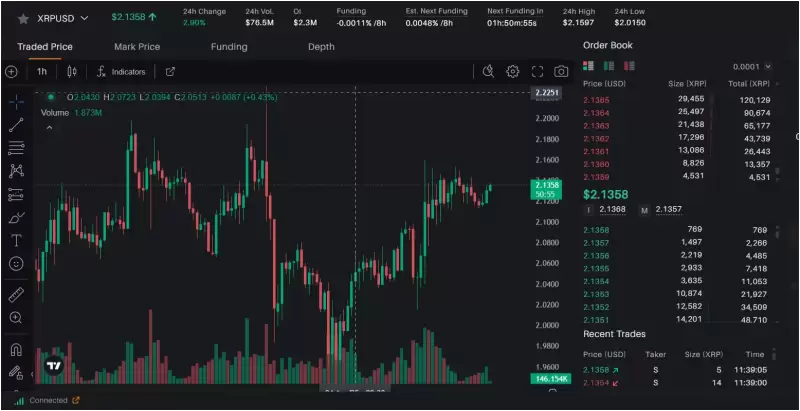 |
|
 |
|
 |
|
 |
|
 |
|
 |
|
 |
|
 |
|
 |
|
 |
|
 |
|
 |
|
 |
|
 |
|
 |
|
截至撰写本文时,DEFI的总价值(TVL)已飙升至802亿美元,几乎翻了一番,比去年的390亿美元翻了一番。
As Web3 technology rapidly advances, new protocols and applications are continually being developed to enhance the efficiency and accessibility of the digital asset landscape. Among the pressing issues that the industry is actively trying to resolve is the efficient management of liquidity and assets across various chains and protocols.
随着Web3技术的迅速发展,不断开发新的协议和应用程序,以提高数字资产格局的效率和可访问性。在该行业正在积极试图解决的紧迫问题中,有效地管理了各种链条和协议的流动性和资产。
While cross-chain technology has made transferring assets between blockchains possible, the process can still be complicated for users and developers. Users may find it difficult to navigate different platforms and interfaces to complete simple tasks like swapping tokens or transferring assets. For developers, integrating multiple cross-chain protocols and liquidity sources can be time-consuming and technically challenging.
虽然跨链技术使区块链之间的资产转移,但对于用户和开发人员来说,该过程仍然很复杂。用户可能会发现很难浏览不同的平台和接口来完成简单的任务,例如交换令牌或转移资产。对于开发人员来说,整合多个跨链协议和流动性来源可能是耗时的,而且在技术上具有挑战性。
Moreover, as the number of chains and protocols increases, liquidity becomes increasingly fragmented. This poses a challenge for both users, who may not obtain the best exchange rates or find the desired liquidity on a single platform, and developers, who need to integrate with a greater variety of protocols to provide broader coverage.
此外,随着链条和协议的数量增加,流动性变得越来越分散。这对两个用户都构成了挑战,他们可能无法获得最佳的汇率或在单个平台上找到所需的流动性,以及需要与更多协议集成以提供更广泛覆盖范围的开发人员。
To address these challenges and create a more seamless Web3 experience, a startup called LI.FI is introducing a suite of products and services that aim to simplify and streamline multi-chain interactions.
为了应对这些挑战并创造更无缝的Web3体验,一家名为Li.Fi的初创公司正在引入一套产品和服务,旨在简化和简化多链交互。
Founded in 2021 by Konstantin Stanislavsky, Ben Maltz, and Michal Pleskot, LI.FI is a startup that focuses on building infrastructure to simplify multi-chain interactions for both users and developers. The startup launched its testing phase in December 2022 and has since raised a total of $70 million to support its development efforts.
Li.fi由Konstantin Stanislavsky,Ben Maltz和Michal Pleskot于2021年创立,是一家专注于建立基础架构的创业公司,以简化用户和开发人员的多链交互。该初创公司于2022年12月推出了测试阶段,此后总共筹集了7,000万美元以支持其发展工作。
LI.FI's core offering is a cross-chain aggregation platform that enables users to seamlessly transfer assets, execute swaps, and interact with various DeFi protocols across multiple chains from a single interface.
Li.Fi的核心产品是一个跨链聚合平台,它使用户能够从单个接口中无缝传输资产,执行交换并与多个链中的各种Fefi协议进行交互。
The startup's technology combines and processes data from over 18 bridges, 38 decentralized exchanges (DEXs) and DEX aggregators, and 30+ chains to provide users with the best available prices, shortest execution times, and smoothest overall transactions.
该初创公司的技术结合了来自18多个桥梁,38个分散交易所(DEX)和DEX聚合器的数据和处理数据,以及30多个链条,以为用户提供最佳的可用价格,最短的执行时间和最顺畅的总交易。
In essence, LI.FI acts as a central hub that connects and coordinates liquidity from different sources, allowing users to perform multi-chain actions with ease.
从本质上讲,Li.Fi充当一个中央枢纽,可连接和协调不同来源的流动性,使用户可以轻松地执行多链操作。
LI.FI is introducing a new level of efficiency and simplicity to the multi-chain experience.
Li.Fi正在为多链体验引入新的效率和简单水平。
Here's a closer look at how LI.FI is solving critical challenges in the DeFi space:
这是Li.fi如何在Defi领域解决关键挑战的仔细研究:
1. Fragmented Liquidity Across Chains
1。跨链的流动性碎片
The increase in the number of chains has seen liquidity become spread across different apps and chains. This makes it harder for users and developers to find the best rates or access the most efficient liquidity. With liquidity being scattered, there’s often higher slippage, suboptimal trading conditions and more manual work to connect to each liquidity source.
连锁链数的增加已经使流动性散布在不同的应用程序和连锁店中。这使用户和开发人员更难找到最优惠的价格或访问最有效的流动性。随着流动性的分散,通常会有更高的滑倒,次优的交易条件以及更多的手动工作,可以连接到每个流动性来源。
To solve this, LI.FI aggregates liquidity from over 30+ chains, 18+ bridges and 38+ DEXs and DEX aggregators into a single platform. Rather than manually navigating fragmented liquidity, users and developers can access everything they need from one place. This means better prices, lower slippage and smoother transactions without having to deal with the complexity of multiple integrations.
为了解决这个问题,li.fi将30多个链条,18多个桥梁和38多个DEX和DEX聚合器的流动性汇总到一个平台中。用户和开发人员无需手动导航零散的流动性,而是可以从一个地方访问所需的一切。这意味着更好的价格,较低的滑倒和光滑的交易,而不必处理多个集成的复杂性。
2. Complex User Experience in Multi-Chain Transactions
2。多链交易中的复杂用户体验
Interacting across chains can be a frustrating experience for users. Swapping, bridging or moving assets typically requires multiple steps and different tools, which makes the process slow and confusing. This complexity discourages users from engaging fully with DeFi.
对于用户来说,跨连锁店进行互动可能是令人沮丧的体验。交换,桥接或移动资产通常需要多个步骤和不同的工具,这使得过程缓慢且令人困惑。这种复杂性使用户无法完全参与Defi。
Zaps, a feature in our stack, streamline the process by bundling multi-step transactions into one action, whether it’s swapping, bridging or staking. We handle the complicated processes behind the scenes, which simplifies multi-chain actions. Through a single API call, users can perform cross-chain swaps, transfers and directly interact with your app, without needing to worry about the underlying steps to get there.
ZAPS是我们堆栈中的一个功能,它通过将多步交易捆绑到一个动作中,无论是交换,桥接还是桩来简化该过程。我们处理幕后复杂的过程,这简化了多链动作。通过单个API调用,用户可以执行跨链交换,转移并直接与您的应用程序进行交互,而无需担心到达那里的基本步骤。
This drastically improves the overall experience by reducing the effort and knowledge required to interact with DeFi.
通过减少与DEFI互动所需的努力和知识,这大大改善了整体体验。
3. Developer Complexity in Integrating Multi-Chain Features
3。开发人员在整合多链特征方面的复杂性
For developers, adding multi-chain functionality is a challenge. They need to intergrate multiple bridges, liquidity sources and protocols, which increases both development time and maintenance costs. This slows down the ability to launch new features or support different chains.
对于开发人员而言,添加多链功能是一个挑战。他们需要将多个桥梁,流动性来源和协议相互融合,这增加了开发时间和维护成本。这减慢了启动新功能或支持不同链条的能力。
With access to a single integration point, developers no longer have to deal with the headache of piecing together different systems.
通过访问单个集成点,开发人员不再需要处理将不同系统拼凑在一起的头痛。
LI.FI offers a range of tools that are available depending on how much control and customisation you require:
Li.Fi提供了一系列工具,这些工具可根据您需要的控制和自定义数量提供。
• APIs and SDKs offer deeper customisation, allowing developers to build cross-chain swaps, bridges and liquidity features in a way that best fits their specific application. These tools provide full control, enabling developers to intergrate features with precision while managing gas fees, optimising routes and minimalising slippage.
•API和SDK提供更深入的自定义,使开发人员可以最适合其特定应用程序建立跨链掉期,桥梁和流动性功能。这些工具提供了完全控制,使开发人员可以在管理汽油费,优化路线和最小化滑移的同时将功能相结合。
• For developers who prefer a quicker solution, Widgets provide a plug-and-play option. With just a few lines of code, developers can integrate multi-chain functionality instantly. This approach is perfect for those who need rapid deployment without the
•对于更喜欢更快解决方案的开发人员,小部件提供了插件选项。只需几行代码,开发人员就可以立即集成多链功能。这种方法非常适合那些需要快速部署的人
免责声明:info@kdj.com
所提供的信息并非交易建议。根据本文提供的信息进行的任何投资,kdj.com不承担任何责任。加密货币具有高波动性,强烈建议您深入研究后,谨慎投资!
如您认为本网站上使用的内容侵犯了您的版权,请立即联系我们(info@kdj.com),我们将及时删除。
-

- 经过数月的ho积后,比特币(BTC)矿工将其持有的40%倾销
- 2025-04-17 17:55:12
- 根据行业数据,15名矿工共同售出了上个月生产的比特币的40%以上。此举标志着与最近的HODL趋势明显变化。
-

-

-

- 基地是由Coinbase支持的区块链网络,在推广一个名为Base的模因硬币后面临反弹
- 2025-04-17 17:50:12
- 最初是一个有趣的想法,可以尝试迅速变成一场噩梦。硬币的价值快速升起,然后坠毁
-

-

-

- 分析师建议,美国政府可能正在悄悄准备库存比特币。
- 2025-04-17 17:40:12
- Galaxy Digital的公司研究负责人Alex Thorn建议,美国政府可能准备在一种新型的战略储备中添加比特币
-

- XRP价格分析:低于$ 2.150的看跌区
- 2025-04-17 17:40:12
- XRP最近进入了下行校正,移至2.150美元以下。从2.250美元的电阻水平撤退后,价格现在正在巩固
-





























































